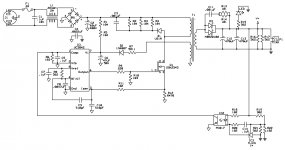I can't say why it was done like this, but there's nothing that says splitting a primary winding to interleave it has to have the same number of turns on each primary layer, so I would presume it was done for some manufacturing reason or it's a relic of the prototype or something.
There's also probably no reason for 3 layers of tape between the outer primary layer and the primary bias layer as there is only a requirement for functional insulation between 2 primary windings 1 layer would have been sufficient.
Flyback transformers, not really being transformers but linked inductors with multiple windings, can have some odd behaviour in the time it transitions from charging through one winding to discharging through the rest. Depending on coupling and leakages, they preferentially discharge through one of the windings first and so you may see things to try to help balance it and make it discharge preferentially though the main secondary power output winding rather than a bias winding. There's an off chance it's something to do with this but I doubt it. The secondary being between the primaries and R7 on the bias winding would be taking care of that.
It looks like a pretty standard flyback converter, I'd be happy to explain any part of the circuit if you get stuck. The only information missing really is the transfomer inductances and gap size, not easy things to measure.
Interesting you assume caps that measure 480pF are meant to be 510pF. I would have assumed 470pF, but it only really matters what they measure.
 The only part I am unsure of is D2, it was unmarked. C9, and C10 measured 480pF so I figured they must really be 510pF.
The only part I am unsure of is D2, it was unmarked. C9, and C10 measured 480pF so I figured they must really be 510pF. 


